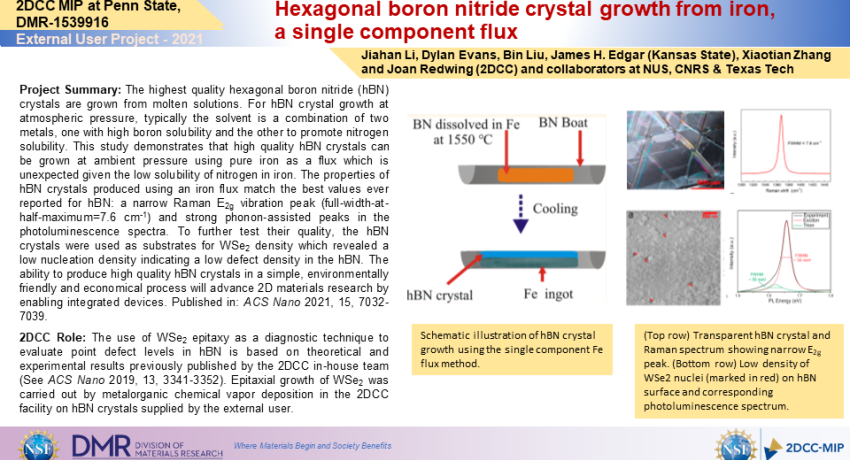Project Summary: The highest quality hexagonal boron nitride (hBN) crystals are grown from molten solutions. For hBN crystal growth at atmospheric pressure, typically the solvent is a combination of two metals, one with high boron solubility and the other to promote nitrogen solubility. This study demonstrates that high quality hBN crystals can be grown at ambient pressure using pure iron as a flux which is unexpected given the low solubility of nitrogen in iron. The properties of hBN crystals produced using an iron flux match the best values ever reported for hBN: a narrow Raman E2g vibration peak (full-width-at-half-maximum=7.6 cm-1) and strong phonon-assisted peaks in the photoluminescence spectra. To further test their quality, the hBN crystals were used as substrates for WSe2 density which revealed a low nucleation density indicating a low defect density in the hBN. The ability to produce high quality hBN crystals in a simple, environmentally friendly and economical process will advance 2D materials research by enabling integrated devices. Published in: ACS Nano 2021, 15, 7032-7039.
2DCC Role: The use of WSe2 epitaxy as a diagnostic technique to evaluate point defect levels in hBN is based on theoretical and experimental results previously published by the 2DCC in-house team (See ACS Nano 2019, 13, 3341-3352). Epitaxial growth of WSe2 was carried out by metalorganic chemical vapor deposition in the 2DCC facility on hBN crystals supplied by the external user.
What Has Been Achieved: Method to grow high quality hBN crystals using a single component iron flux at atmospheric pressure.
Importance of the Achievement: hBN is widely used as a encapsulant layer for graphene and 2D chalcogenides to provide dielectric screening. The majority of studies currently use hBN bulk crystals produced by high pressure synthesis using multicomponenet molten solutions. The ability to synthesize high quality hBN by the iron flux technique at atmospheric pressure provides a simple and economic method which will advance the field of 2D materials research.
Unique Feature(s) of the MIP that Enabled this Achievement: The use of WSe2 epitaxy as a diagnostic technique to evaluate point defect levels in hBN is based on theoretical and experimental results previously published by the 2DCC in-house team (See ACS Nano 2019, 13, 3341-3352). Epitaxial growth of WSe2 was carried out by metalorganic chemical vapor deposition in the 2DCC facility on hBN crystals supplied by the external user.
(If Applicable) Publication:
J. Li, J. Wang, X. Zhang, C. Elias, G. Ye, D. Evans, G. Eda, J.M. Redwing, G. Cassabois, B. Gil, P. Valvin, R. He, B. Liu and J.H. Edgar, “Hexagonal boron nitride crystal growth from iron, a single component flux,” ACS Nano 2021, 15(4), 7032-7039. https://doi.org/10.1021/acsnano.1c00115
The crystal growth (J.L. and J.H.E.) in this study was supported by the Materials Engineering and Processing program of the National Science Foundation, Award No. CMMI 1538127. B.L. is grateful for the support by NSF Grant No. CHE-1726332. J.W. and G.E. acknowledge the Singapore National Research Foundation for funding the research under the medium-sized centre programme. G.E. also acknowledges support from the Ministry of Education (MOE), Singapore, under AcRF Tier 3 (Grant No. MOE2018-T3-1-005). X.Z. and J.M.R. acknowledge the support of the National Science Foundation (NSF) through the 2D Crystal Consortium-Materials Innovation Platform (2DCC-MIP) under NSF Cooperative Agreement DMR-1539916. Work at Texas Tech University (G.Y. and R.H.) is supported by an NSF CAREER Grant (No. DMR-1760668). This work was financially supported in France by the contract BONASPES (ANR-19-CE30-0007-02) under the umbrella of the publicly funded Investissements d’Avenir program managed by the French ANR agency.
